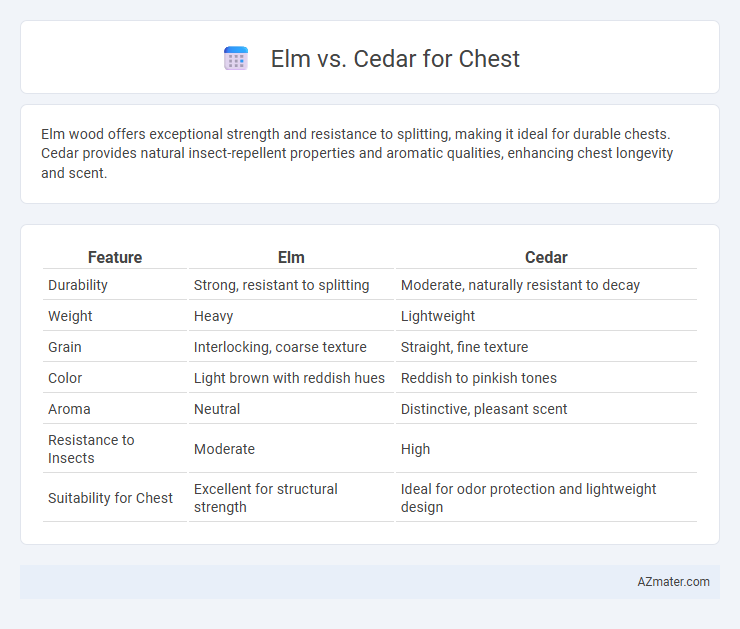Elm wood offers exceptional strength and resistance to splitting, making it ideal for durable chests. Cedar provides natural insect-repellent properties and aromatic qualities, enhancing chest longevity and scent.
Table of Comparison
| Feature | Elm | Cedar |
|---|---|---|
| Durability | Strong, resistant to splitting | Moderate, naturally resistant to decay |
| Weight | Heavy | Lightweight |
| Grain | Interlocking, coarse texture | Straight, fine texture |
| Color | Light brown with reddish hues | Reddish to pinkish tones |
| Aroma | Neutral | Distinctive, pleasant scent |
| Resistance to Insects | Moderate | High |
| Suitability for Chest | Excellent for structural strength | Ideal for odor protection and lightweight design |
Introduction to Elm and Cedar Wood
Elm wood is valued for its interlocking grain and durability, making it ideal for furniture and cabinetry that require strength and flexibility. Cedar wood, known for its aromatic scent and natural resistance to decay and insects, is frequently used in chests and outdoor storage. Both woods offer distinct advantages, with elm providing sturdiness and cedar offering protection against environmental damage.
Historical Uses of Elm and Cedar in Furniture
Elm wood has historically been prized for its interlocking grain, which provides strength and resistance to splitting, making it a preferred choice for sturdy furniture such as chests and cabinets during the 17th and 18th centuries. Cedar, known for its natural aromatic oils that repel moths and insects, has been traditionally used in chest construction to protect stored textiles and valuables, especially in European and North American craftsmanship. Both woods offer durability, but elm's toughness suited heavy-use furniture while cedar's preservative qualities catered to protective storage solutions.
Physical Characteristics of Elm vs Cedar
Elm wood typically features a coarse, interlocked grain with a medium to coarse texture, offering good strength and resistance to splitting, making it durable for furniture and structural uses. Cedar exhibits a fine, straight grain with a smooth texture and natural oils that provide resistance to decay and insects, contributing to its longevity in outdoor applications. In terms of color, elm ranges from light to medium brown with subtle reddish hues, while cedar displays a reddish to pinkish tone, enhancing its aesthetic appeal for decorative purposes.
Durability and Longevity Comparison
Elm wood exhibits excellent durability with strong resistance to splitting and decay, making it a reliable choice for chest construction. Cedar offers superior natural resistance to moisture, insects, and rot, ensuring exceptional longevity in diverse environments. While both woods provide durability, cedar's inherent qualities often result in longer-lasting chests, especially in humid or outdoor conditions.
Resistance to Pests and Decay
Elm wood exhibits moderate resistance to pests and decay but is more prone to fungal attacks and insect damage compared to cedar. Cedar is renowned for its natural oils and compounds, such as thujaplicins, which provide excellent resistance to rot, decay, and insect infestations, making it a superior choice for chest construction in terms of longevity. The high durability of cedar wood significantly reduces maintenance and increases the lifespan of chests exposed to varying environmental conditions.
Aroma and Natural Properties
Elm wood offers a mildly sweet and earthy aroma with natural anti-fungal properties, making it a popular choice for chest furniture that benefits from durability and subtle fragrance. Cedar wood emits a strong, distinctive scent rich in natural oils known for repelling insects and providing excellent moisture resistance, enhancing both the preservation and aromatic appeal of chests. Both woods contribute unique natural benefits to chest construction, with elm focusing on gentle fragrance and durability, while cedar excels in aromatic intensity and protective qualities.
Workability and Craftsmanship
Elm features interlocking grain that offers excellent strength but can challenge smooth planing, requiring skilled craftsmanship for fine finishes. Cedar, known for its straight grain and softness, excels in workability, allowing easy shaping and sanding, ideal for intricate chest details. Both woods demand different woodworking techniques, with Elm offering durability and Cedar providing effortless carving and a pleasant aromatic quality.
Aesthetic Appeal: Grain, Texture, and Color
Elm wood features a distinctive interlocking grain pattern with a coarse texture, offering a rugged yet warm aesthetic ideal for rustic or traditional chest designs. Cedar boasts a straight, fine grain with a smooth texture and rich reddish-brown hues that deepen over time, enhancing the elegance and natural beauty of chests. Both woods provide unique visual characteristics, with elm emphasizing robust patterns and cedar delivering a refined, aromatic appeal.
Cost Differences and Availability
Elm wood typically commands a higher price than cedar due to its density and durability, making it a costlier option for chest construction. Cedar is generally more affordable and widely available, especially in North America, thanks to its rapid growth and extensive commercial cultivation. Availability of elm is limited compared to cedar, which can impact overall project timelines and material sourcing.
Best Uses: Which Wood is Ideal for Chests?
Elm wood offers excellent durability and natural resistance to splitting, making it ideal for sturdy, heavy-use chests that require robust construction and a warm, rich grain pattern. Cedar is renowned for its lightweight nature, aromatic properties, and natural insect-repellent qualities, perfect for chests intended for storing clothing or linens where protection from moths and freshness is prioritized. Choosing elm suits heavy-duty, rustic chests, while cedar excels in creating fragrant, protective storage solutions for textiles.

Infographic: Elm vs Cedar for Chest
 azmater.com
azmater.com